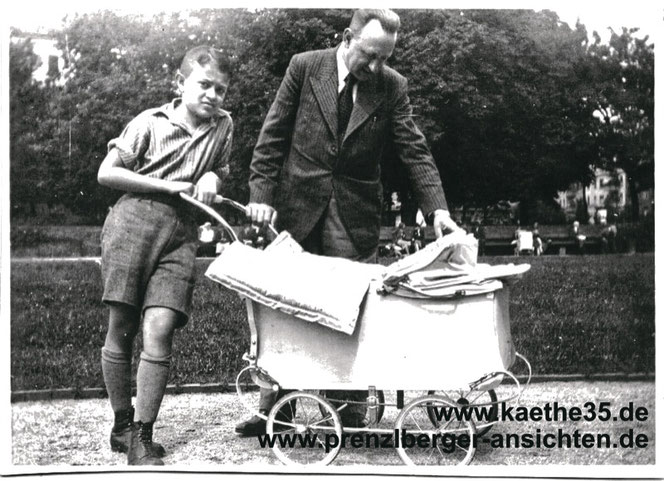JEWISH LIFE IN PRENZLAUER BERG, PART 5
HOPP FAMILY
Jan. 27 marked the 77th anniversary of the liberation of Auschwitz by the Red Army. Before some 7,000 survivors were liberated, more than a million people had been murdered there in less than five years earlier. In Berlin, the Silent Bell Board at Käthe-Niederkirchner-Str. 35 has been commemorating the former Jewish residents of the house since 2019 with 83 individual names - 34 of whom died in Auschwitz.
However, a few of the 83 names also stand for survival. And for biographies that could be continued elsewhere and did not end with this address in the Bötzowviertel as the penultimate station.
Thus, the doorbell plate of the Hopp family bears seven first names: Jeanette∙Ruth∙Nathan∙Tana∙Siegfried∙Doris∙Manfred. With families Baruch and Klein there were other relatives in the house. Three of them survived the Nazi tyranny: the couple Ruth and Nathan Hopp and their daughter Tana.

Born on May 8, 1939, Tana Hopp is the youngest inhabitant of the house to be registered in the course of the 1939 census. In preparation for the deportations that began shortly thereafter, the "supplementary cards" also requested information as to whether "one of the four grandparents was or is a full Jew by race“. And Tana Hopp - today living in Lititz/Pennsylvania - is one of the few contemporary witnesses who was able to make an invaluable contribution to remembering her family in Berlin as well.
She wrote: "Even though I was only 10 months old when we left I grew up absorbing all that had happened to my family through my parents and I suppose I have always experienced a degree of what one calls "surviver's guilt". [...] When I was born we were living in Suedende where my father owned a couple of lady's dress shops. These were destroyed on Kristallnacht and shortly after the landlord Of our building evicted us as he no longer wanted Jews living there. That was when we moved to Leppener Str. 35 and lived with my father's brother, Siegfried, his wife and son until our departure for Brazil."

Her father Nathan Hopp was born in 1893 in Schulitz as one of five children of his parents Jeanette and Markus. While he - awarded the Iron Cross "for bravery as a front-line fighter" - leaves his now Polish homeland with his family in 1918 and moves to Berlin, his future wife Ruth Seide, born in 1905, grows up in Berlin with her parents Elfriede and Richard (both deported to the Litzmannstadt/Łódź ghetto in 1941).
Moving to Prenzlauer Berg, Nathan runs the fashion store "Leopold & Hopp" together with his sister Martha's husband, Leo Leopold, at 192 Greifswalder Str. on the corner of Chodowieckistr. (the prominent corner buildings destroyed five years later, today plain post-war modernism). Martha and Leo emigrate to Brazil in 1938.
In January 1940, Nathan places an ad in the Jewish News Gazette: "Looking for some large used suitcases".
At the beginning of March 1940 the young family manages to move to São Paulo, after depositing the "Reichsfluchtsteuer" („Reich Flight Tax“, a quarter of all assets) and just in time before this possibility is also stopped.
Nathan's older brother Siegfried lives with his wife Doris (called Dora) and son Manfred (born 1927) last at Wehlauer Str. (today Eugen-Schönhaar-Str.) 1. At the end of October 1941, the family is deported to Łódź and murdered in Kulmhof (Chełmno) on May 4, 1942.
Their mother Jeanette is last in the "Siechenheim" Auguststraße 14-16, before she is taken to Theresienstadt in January 1943 and dies there a week later at the age of 83.
A few days later, Nathan's sister Lucie is deported to Auschwitz with her husband Max Klein and son Manfred (born 1925) and murdered. Nathan's niece Edith Baruch, who already prepared for emigration at the "Hachschara Center" Gut Skaby near Friedersdorf, survives Auschwitz for almost six months in 1943 and dies there at the age of 21.
"As you can imagine my parents had a very hard time adjusting to Brazil in the beginning, having left all their family behind, the wonderful cultural world of Berlin to which they were accustomed and having to learn a new language and adapt to new costumes was not easy. Together with my uncle Leo they eventually re-established themselves, learned to speak Portuguese and were part of a large and wonderful German-Jewish community."
In 1954, Nathan and Leo have a modern 7-story apartment building built in São Paulo by architect Bernardo Rzezak, the "Edificio Tana." After their daughter's marriage to Dr. Elliot Dardik and the birth of grandchildren Ari and Alyssa, Nathan and Ruth move in with them in Philadelphia in 1967. Nathan dies there in 1984, Ruth in 1993. In October 2019, Tana and her daughter met at New York's Central Park with the author of this article which is dedicated to Tana.
Simon Lütgemeyer / M. Steinbach
Source : www.kaethe35.de

